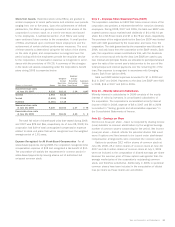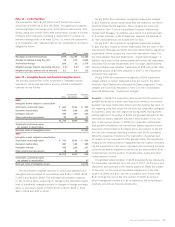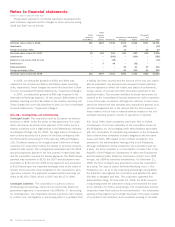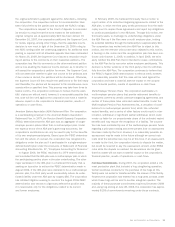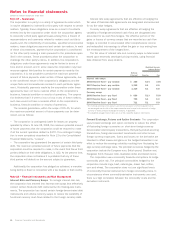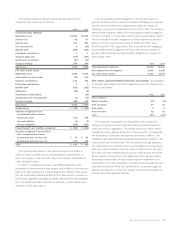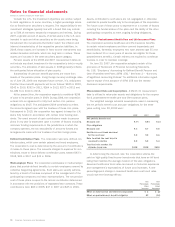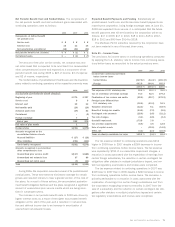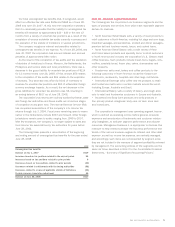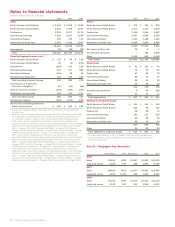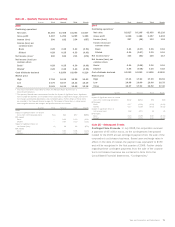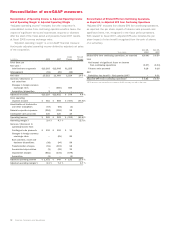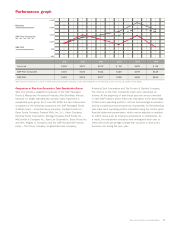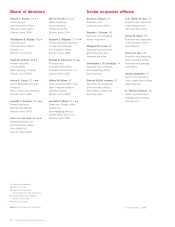Sara Lee 2008 Annual Report Download - page 72
Download and view the complete annual report
Please find page 72 of the 2008 Sara Lee annual report below. You can navigate through the pages in the report by either clicking on the pages listed below, or by using the keyword search tool below to find specific information within the annual report.
Notes to financial statements
Dollars in millions except per share data
Outside the U.S., the investment objectives are similar, subject
to local regulations. In some countries, a higher percentage alloca-
tion to fixed-income securities is required. The responsibility for the
investment strategies typically lies with a board that may include
up to 50% of members elected by employees and retirees. During
2007, a greater amount of assets of certain plans in the U.K. were
invested in cash and other securities as the assets were being
transitioned into investments that better match the inflation and
interest characteristics of the respective pension liabilities. In
2008, these assets are invested in fixed income investments and
related derivative contracts, which are long term in nature. These
assets are included in the debt securities asset category.
Pension assets at the 2008 and 2007 measurement dates do
not include any direct investment in the corporation’s debt or equity
securities. The allocation of plan assets in 2008 generally reflects
the anticipated future allocation of plan assets.
Substantially all pension benefit payments are made from
assets of the pension plans. Using foreign currency exchange rates
as of June 28, 2008 and expected future service, it is anticipated
that the future benefit payments will be as follows: $245 in 2009,
$242 in 2010, $252 in 2011, $264 in 2012, $272 in 2013 and
$1,486 from 2014 to 2018.
At the present time, the corporation expects to contribute $196
of cash to its pension plans in 2009. During 2006, the corporation
entered into an agreement to fully fund certain U.K. pension
obligations by 2015. The anticipated 2009 contributions reflect
the amounts agreed upon with the trustees of these U.K. plans.
Subsequent to 2015, the corporation has agreed to keep the U.K.
plans fully funded in accordance with certain local funding stan-
dards. The exact amount of cash contributions made to pension
plans in any year is dependent upon a number of factors including
minimum funding requirements in the jurisdictions in which the
company operates, the tax deductibility of amounts funded and
arrangements made with the trustees of certain foreign plans.
Defined Contribution Plans The corporation sponsors defined con-
tribution plans, which cover certain salaried and hourly employees.
The corporation’s cost is determined by the amount of contributions
it makes to these plans. The amounts charged to expense for con-
tributions made to these defined contribution plans totaled $43 in
2008, $38 in 2007 and $33 in 2006.
Multi-employer Plans The corporation participates in multi-employer
plans that provide defined benefits to certain employees covered by
collective bargaining agreements. Such plans are usually adminis-
tered by a board of trustees composed of the management of the
participating companies and labor representatives. The net pension
cost of these plans is equal to the annual contribution determined
in accordance with the provisions of negotiated labor contracts. These
contributions were $48 in 2008, $47 in 2007 and $45 in 2006.
Assets contributed to such plans are not segregated or otherwise
restricted to provide benefits only to the employees of the corporation.
The future cost of these plans is dependent on a number of factors
including the funded status of the plans and the ability of the other
participating companies to meet ongoing funding obligations.
Note 20 – Postretirement Health-Care and Life-Insurance Plans
The corporation provides health-care and life-insurance benefits
to certain retired employees and their covered dependents and
beneficiaries. Generally, employees who have attained age 55 and
have rendered 10 or more years of service are eligible for these
postretirement benefits. Certain retirees are required to contribute
to plans in order to maintain coverage.
On June 30, 2007, the corporation adopted certain of the
provisions of Statement of Financial Accounting Standards
No. 158, “Employers’ Accounting for Defined Benefit Pension and
Other Postretirement Plans (SFAS 158).” See Note 2 – “Summary
of Significant Accounting Policies” for additional information regard-
ing the impact of the adoption of SFAS 158 and the related
disclosure requirements.
Measurement Date and Assumptions A March 31 measurement
date is utilized to value plan assets and obligations for the corpora-
tion’s postretirement health-care and life-insurance plans.
The weighted average actuarial assumptions used in measuring
the net periodic benefit cost and plan obligations for the three
years ending June 28, 2008 were:
2008 2007 2006
Net periodic benefit cost
Discount rate 5.7% 5.5% 5.1%
Plan obligations
Discount rate 6.4 5.7 5.5
Health-care cost trend assumed
for the next year 9.5 9.5 8.6
Rate to which the cost trend is
assumed to decline 5.5 5.5 5.3
Year that rate reaches the
ultimate trend rate 2015 2015 2010
In determining the discount rate, the corporation utilizes the
yield on high-quality fixed-income investments that have an AA bond
rating that matches the average duration of the plan obligations.
Assumed health-care trend rates are based on historical experience
and management’s expectations of future cost increases. A one-
percentage-point change in assumed health-care cost trend rates
would have the following effects:
One One
Percentage Percentage
Point Point
Increase Decrease
Effect on total service and interest components $÷2 $÷(2)
Effect on postretirement benefit obligation 22 (16)
70 Sara Lee Corporation and Subsidiaries



